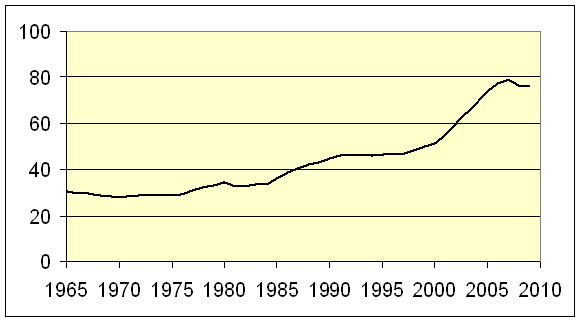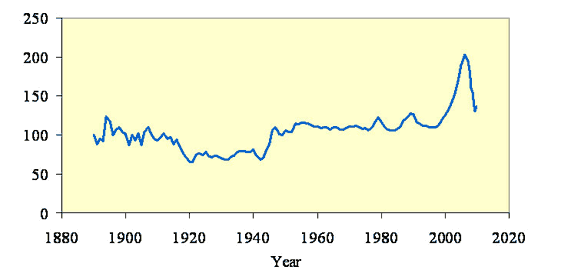University of Chicago Professor John Cochrane (hat tip: Capital Spectator) has an interesting analysis of the causes of the financial problems of the last few years.
The signature event of this financial crisis was the “run,” “panic,” “flight to quality,” or whatever you choose to call it, that started in late September of 2008 and receded over the winter. Short-term credit dried up, including the normally straightforward repurchase agreement, inter-bank lending, and commercial paper markets. If that panic had not occurred, it is likely that any economic contraction following the housing bust would have been no worse than the mild 2001 recession that followed the dot-com bust….
Why was there a financial panic? There were two obvious precipitating events: the failure of Lehman Brothers investment bank in the context of the Bear Stearns, Fannie Mae, Freddie Mac and AIG bailouts; and the chaotic days in Washington surrounding the passage of legislation establishing the Troubled Asset Relief Program (TARP).
Why would Lehman’s failure cause a panic? Why, after seeing Lehman go to bankruptcy court, would people stop lending to, say, Citigroup, and demand much higher prices for its credit default swaps (insurance against Citi failure)? Nothing technical in the Lehman bankruptcy caused a panic. The usual “systemic” bankruptcy stories did not happen: We did not see a secondary wave of creditors forced into bankruptcy by Lehman losses. Most of Lehman’s operations were up and running in days under new owners. Lehman credit default swaps (CDSs) paid off. Sure, there was some mess– repos in the United Kingdom got stuck in bankruptcy court, some money market funds “broke the buck” and had to borrow from the Fed– but those issues are easy to fix and they do not explain why Lehman’s failure would cause a widespread panic. What is more, Lehman’s failure did not carry any news about asset values; it was obvious already that those assets were not worth much and illiquid anyway.
We are left with only one plausible explanation for why Lehman’s failure could have had such wide-ranging effect: After the Bear Stearns bailout earlier in the year, markets came to the conclusion that investment banks and bank holding companies were “too big to fail” and would be bailed out. But when the government did not bail out Lehman, and in fact said it lacked the legal authority to do so, everyone reassessed that expectation. “Maybe the government will not, or cannot, bail out Citigroup?” Suddenly, it made perfect sense to run like mad….
Let us go back one step further. Why did Lehman fail– along with Fannie Mae, Freddie Mac, AIG, Wamu, and very nearly Citigroup and Bank of America? Here is where I part company on the usual worries about bubbles, imbalances, silly mortgages, and so on.
The underlying decline in wealth from the housing bust was not that large…. Most estimates put subprime losses around $400 billion. The stock market absorbs losses like that in days. But it turned out that housing risks are spread very differently from stock market risks.
The difference is that mortgages were held in very fragile financial structures. An extreme example: many mortgages were pooled into securities, and the securities were held in special purpose vehicles (SPVs), funded by rolling over short term commercial paper with an off-the-books credit guarantee from a large bank. Less extreme: when Bear Stearns failed, it was holding a large portfolio of mortgage-backed securities (MBSs) funded at 30-to-1 leverage by overnight debt. In both cases, when the mortgages lose value, the debt-holders refuse to renew their loans and the whole thing blows up. In contrast, when your (and my) pension account loses value, we cannot run for the exits and try to make someone else hold the losses.
John raises a number of interesting points. But I must say that I put more weight than he does on “the usual worries about bubbles, imbalances, silly mortgages, and so on.” The problem is not just the fragility of the system in 2008, but the huge flows of capital into these devices in the years leading up to the crisis. U.S. home mortgage debt grew much more quickly than income, with almost $8 trillion in gross new U.S. household mortgage debt issued between 2004 and 2006 alone.

Net U.S. home mortgage debt as a percentage of GDP, 1965-2009. Mortgage data: end of year numbers 1965-2008 and end of third quarter value for 2009, from Federal Reserve Board Flow of Funds, Table L2. Nominal GDP from BEA Table 1.1.5.
A graph of real home prices is remarkable not just for the dramatic descent since 2006 (which began two years before John picks up the story) but moreover for the meteoric rise between 2000 and 2005.

Shiller’s real home price index, 1890-2009. Source: Irrational Exuberance, Princeton, 2005, by Robert Shiller.
My view is that there were very serious problems with the U.S. financial system prior to 2008. But I think John has correctly described part of the reason why the failure of Lehman was such an important event.
John Cochrane on the credit crisis
- Bulenox: Get 45% to 91% OFF ... Use Discount Code: UNO
- Risk Our Money Not Yours | Get 50% to 90% OFF ... Use Discount Code: MMBVBKSM
Disclaimer: This page contains affiliate links. If you choose to make a purchase after clicking a link, we may receive a commission at no additional cost to you. Thank you for your support!


//wallstreetpit.com/15844-john-cochrane-on-the-credit-crisis
John Cochrane on the Credit Crisis
By James D. Hamilton|Jan 31, 2010, 12:56 PM|Author’s Website
University of Chicago Professor John Cochrane has an interesting analysis of the causes of the financial problems of the last few years.
Cochrane writes:
The signature event of this financial crisis was the “run,” “panic,” “flight to quality,” or whatever you choose to call it, that started in late September of 2008 and receded over the winter. Short-term credit dried up, including the normally straightforward repurchase agreement, inter-bank lending, and commercial paper markets. If that panic had not occurred, it is likely that any economic contraction following the housing bust would have been no worse than the mild 2001 recession that followed the dot-com bust….
Why was there a financial panic? There were two obvious precipitating events: the failure of Lehman Brothers investment bank in the context of the Bear Stearns, Fannie Mae, Freddie Mac and AIG bailouts; and the chaotic days in Washington surrounding the passage of legislation establishing the Troubled Asset Relief Program (TARP).
————————————————————————————-
This opinion, shared by many, is correct, however, yet again, no mention is made of the singular event that occurred in late September, that started the panic. Sources closer and more knowledgeable of the events of that time, have pointed out that it was the seizure of Wamu, that precipitated the true beginning of the meltdown, even the normally clueless Tim Geithner, was said to be furious at Sheila Bair’s actions on that day in September.
As the Professor pointed out, short-term credit, and interbank lending, ceased almost overnight, as a shocked banking community realized, that nothing was impossible, and the FDIC had turned from protector, to predator.
Sheila Bair in the months to come, would make multiple PSA’s, lauding her agency’s “protection of depositors”, an outrage in of itself. Sheila Bair, almost single-handedly, destroyed 10’s if not 100’s of thousands of investors and shareholders. The result of her actions, also DIRECTLY caused the failure of many dozens of the banks that followed for the reasons stated above, SHE was the self-fulfilling prophecy that wiped out trillions in wealth in this country. The Dow lost more than a couple of THOUSAND extra points, that wouldn’t have been lost, had she not began the the single most destructive “regulatory” act in American history.
Sheila Bair is the modern day equivalent, of the Mrs. O’Leary’s Cow of legend, the only difference is, THAT cow, was not WILLFULLY ignorant and destructive.
It is high time this one was put out to pasture, and never allowed near a lantern again.
WaMu Shareholders Appointed an Equity Committee, Gain Representation in Bankruptcy Proceedings
http://www.youtube.com/watch?v=IeXtCiU2IeA